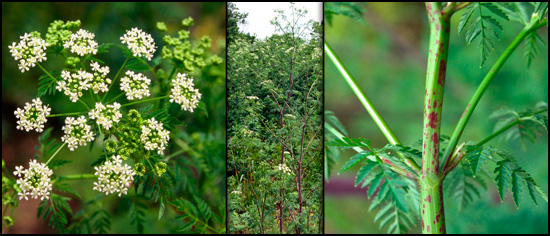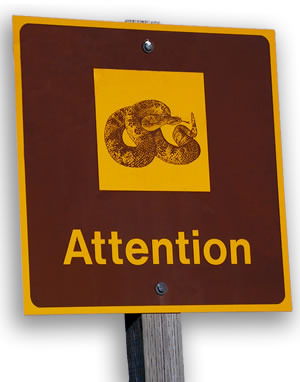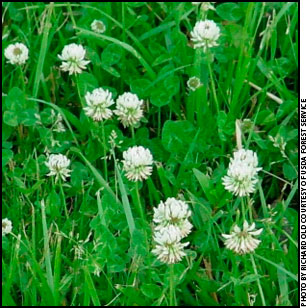HEALTH & NUTRITION...

Keep Livestock
Away
from Poison Hemlock
Commonly found in wet, wooded areas and open fields, along roadsides and railroad tracks, this poisonous plant could cause abortions and death in cattle.
The carrot family, which boasts a variety of familiar edibles such as parsley, celery, carrots, anise, fennel and cilantro, also contains a highly poisonous plant that many people confuse for its nontoxic counterparts.
Stan Smith, an Ohio State University (OSU) Extension program assistant in agriculture and natural resources, said people should learn to recognize poison hemlock. The noxious weed looks similar to and smells like other plants in the carrot family (Apiaceae, formerly known as Umbelliferae). Poison hemlock (Conium maculatum) originated in Europe, but is now commonly found in Ohio, growing in wet, wooded areas and open fields, and along roadsides and railroad tracks. Read more.
Dealing with Snakebite
Snakebite is a risk wherever livestock coexist with rattlers, copperheads or other varieties of venomous snakes. Texas A&M University Assistant Professor and Extension Veterinarian John Davidson jokingly tells veterinary students that snakes generate a lot of business for animal doctors. Sometimes that's all too true and not very funny. When Davidson was in private practice, calls to attend snakebit animals were common during the spring months when snakes were most active.
 "When I was in mixed practice, I saw snakebite in everything from pets to various livestock species," Davidson says. "I consider a bite by a poisonous snake to be a veterinary emergency. If a bite delivers enough venom in the right location it can be fatal."
"When I was in mixed practice, I saw snakebite in everything from pets to various livestock species," Davidson says. "I consider a bite by a poisonous snake to be a veterinary emergency. If a bite delivers enough venom in the right location it can be fatal."
In many instances, cattle and horses are bitten on the muzzle — probably the worst possible place. The victim's reaction depends on the amount and potency of snake venom. Typically, edema or swelling of tissues at and near the bite begins almost immediately. As the venom is absorbed into the bloodstream, the cardiovascular system may also be affected, and blood pressure drops. The animal becomes weak and may go down.
Davidson says it's the severe swelling that usually poses the greatest risk to animals bitten on the nose, since it hinders their ability to breathe. In his experience, most animals that die as a result of snakebite succumb to asphyxiation. This is particularly true in horses, which have more difficulty breathing through their mouths than cattle.
In the event an animal is bitten by a poisonous snake, Davidson advises producers to call a veterinarian as soon as possible.
"If a horse or show calf or some animal wearing a halter is bitten on the head, get the halter off right away," Davidson warns. "As the nose and face swells, the halter will get tighter and only make things worse. If the animal's nose is swelling rapidly, inserting pieces of garden hose or other tubing in the nostrils may help ease its breathing while waiting for the veterinarian to arrive."
A veterinarian attending a snakebit animal typically administers anti-inflammatory drugs to ease swelling, followed by antibiotic therapy to ward off a secondary bacterial infection. As with any puncture wound, Davidson says treatment with tetanus antitoxin generally is advised.
Custom Mix
When should producers consider a customized mineral supplement?
Typically, the local feed supplier stocks one or more brands of mineral supplement for cattle on forage diets. These products generally contain predetermined amounts of the dietary mineral elements most classes of cattle require for normal body maintenance, growth and reproduction. In most cases, producers can find satisfactory supplements among the ample number of commercially available products produced by reputable companies.
However, because forage nutrient profiles vary, specific mineral needs also vary by region, and among different operations. Mass-produced commercial supplements may not always supply appropriate amounts of certain minerals. In such instances, a custom-mixed supplement can be formulated to provide proper levels of minerals, based on analysis of cattle diet. Read more.

Rick Rasby
Ridin’ Herd
This may be the summer to store DG
This was an interesting winter for feeding because of the availability of distillers' grain (DG) for cow-calf producers at a reasonable price. There were many occasions this winter when DG was priced at 70% the price of corn. Because DG has a greater energy value than corn, this made it very economical and an extremely good buy when calculated per unit of total digestible nutrients (TDN).
Research indicates that grain byproducts and forages, when fed together, have a positive associative relationship. That means that when DG is fed with forages, there is no reduction in the digestibility of the forage and no decrease in forage intake.
The price of DG usually decreases in the summer as cattle-on-feed numbers decrease. This may be the summer to be prepared to buy DG, store it, then feed it when cows need to be supplemented protein, energy, or both. Read more.
Protect Investments with BRD Control
Just like investors watch the stock market, producers should watch their cattle — each is an investment in time, labor and inputs that needs to perform at its best. One of the quickest and most costly ways an animal's performance can be downgraded is by developing bovine respiratory disease (BRD).
"Watching for the situations that we know can result in BRD can give producers a head start in managing the disease and protecting against lost gain and profits," says veterinarian Lee Bob Harper, Pfizer Animal Health Veterinary Operations. "If you're not on the lookout, BRD's effects can create reduced performance over an animal's entire lifetime."1 Read more.
Controlling Trich
Management and vaccination keep trichomoniasis at bay.
Trichomoniasis, commonly referred to as “Trich,” is a growing problem among cow herds. Predominantly found in southern and western states, this disease is caused by the protozoa Tritrichomonas foetus. Trichomoniasis is a venereal disease transmitted at breeding and results in early embryonic death and abortion of the fetus. This can cause devastating economic setbacks for cattle producers.
“Often, the first sign of Trich is open cows or cows calving significantly late,” says Joe Campbell, professional services veterinarian with Boehringer Ingelheim Vetmedica Inc. (BIVI).
An infected bull transmits the disease to the cow at breeding; she then aborts the fetus early in pregnancy and ultimately comes into heat later in the breeding season. If she becomes pregnant late in the season, her resulting calf will be smaller than its peers. In some cases, the cow may not conceive again, and she will not deliver a calf that year. Read more.
 Clover Causing Bloat
Clover Causing Bloat
Abundant clover setting stage for cattle bloat problems.
Reportings of frothy bloat in cattle are up quite a bit in 2010 compared to recent years. Several University of Kentucky (UK) College of Agriculture specialists weighed in with possible explanations for the higher incidence of bloat. Ray Smith, Extension forage specialist, said he and his colleagues have been in regular contact with livestock producers and industry representatives throughout the state.
"We have heard about and seen an overabundance of white clover in many pastures this year," he said. "This has raised concerns about bloat, and a number of producers have experienced death losses due to bloat in their cattle herds." Read more.
Cattle Diseases: Common Conditions/Terms
Click here for a list of common conditions and terms related to beef cattle diseases, such as anaplasmosis, brucellosis, BVD, E. coli, IBR and others.
[Click here to go to the top of the page.]





